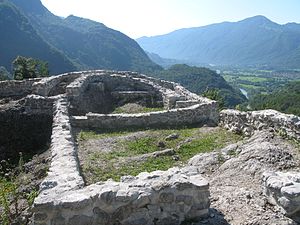Tonovcov grad
| Tonovcov grad | ||
|---|---|---|
| height | 412 m. i. J. | |
| location | Slovenia | |
| Mountains | Julian Alps | |
| Coordinates | 46 ° 14 ′ 52 " N , 13 ° 35 ′ 20" E | |
|
|
||
| particularities | Traces of settlement from the Stone Age to the Middle Ages | |
Tonovcov grad is a hill in the upper valley of the Isonzo (Slovenian: Soča ) in Slovenia . The elevation lies above Kobarid and was a hillside settlement from late antiquity .
location
The elevation is located directly on the Isonzo (Slovenian: Soča) and is characterized by steeply sloping flanks. As a result, it blocks the passage of the valley, which was at times of great strategic importance. Opposite, on the western side of the river, below the hill is the small town of Kobarid. The summit plateau, which was protected by rocks and at times also by stone walls, covers an area of 150 × 90 m.
Settlement history
Traces of settlement show that the mountain was already used in the Mesolithic . In late Roman times, the square, together with the neighboring Gradič hill, was of great strategic importance and was one of the most important bases of Claustra Alpium Iuliarum . This was a system of fortifications in the Julian Alps that was built to secure the approaches to Italy against invading barbarians. For example, the important direct connection over the Predil Pass between Forum Iulii and Carinthia could be controlled. The importance of Tonovcov grad has been rated even higher since excavations showed that no Roman fortifications have been found on the Bardo hill near San Pietro al Natisone , where this road was supposed to be blocked.
There is evidence of a Roman hilltop settlement as early as the 3rd century AD. Coins, bronze and iron objects, but no building remains are known from this time. It is unclear whether a fortification wall was built back then. In the second half of the 4th century and at the beginning of the 5th century the intensity of the settlement seems to have increased according to the finds. Wall remnants and results of comparable settlements ( Rifnik , Brinjeva gora ) indicate a fortification during this period. However, this is not guaranteed. The metal finds are comparable to those of the important Roman fortress Ad Pirum on the pass of the Birnbaumer Forest . Numerous weapons finds from this period suggest a military occupation.
Tonovcov grad played its most important role in the late 5th century and during the 6th century when the area was first part of the Ostrogothic Empire , then was briefly reclaimed by the East and finally conquered by the Lombards . The ruins on the plateau date from this time and apparently represented residential buildings, fortifications, cisterns and three churches. Some of the buildings were quite large and often had several rooms; the churches, including the narthexe, were about 20 × 17 m. The settlement itself was protected by rock faces and stone walls. Surrounded by another wall, there was a smaller outer bailey directly in front of the settlement, apparently to take in refugees from other places or cattle. A fourth church may represent an Arian church that could have been built during the rule of the Ostrogoths or Lombards. The presence of a Lombard occupation in the late 6th century is attested by the discovery of a bow brooch and a spathe . It is not known whether the Goths, to whose empire the fortress had previously belonged, also stayed here. The majority of the population at that time seems to have been Romansh . Bow brooches, crossbow brooches, earrings and iron pins are evidence of this. With the invasion of the Slavs around 600, many of the fortifications in Slovenia were abandoned. How long the Tonovcov grad settlement continued to exist after the end of the 6th century is unclear.
The later Slavic population seems to have settled in the dilapidated ancient buildings. How long this last phase of settlement lasted is unclear. A Carolingian belt tongue from around 800 and an Avar belt fitting from the same period speak of this phase .
Individual evidence
- ↑ a b c d e Slavko Ciglenečki: Castra and hillside settlements from the 3rd to 6th centuries in Slovenia (p. 511 ff.). In: Heiko Steuer , Volker Bierbrauer (Ed.): Hill settlements between antiquity and the Middle Ages from the Ardennes to the Adriatic. With the assistance of Michael Hoeper. de Gruyter, Berlin et al. 2008, ISBN 978-3-11-020235-9 , ( Reallexikon der Germanischen Altertumskunde supplementary volumes 58).


